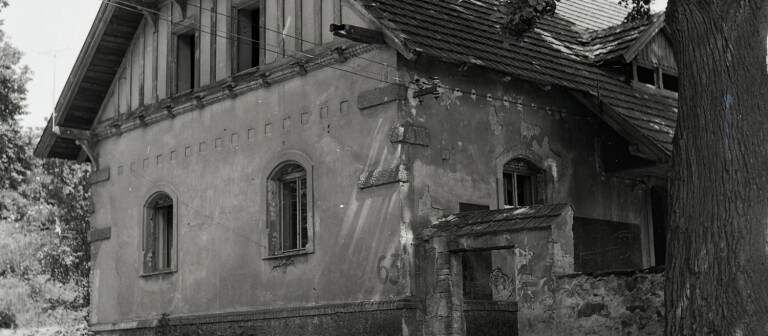
Babiny I
The following text is taken from the document "Notes on the Design of the Municipal Coat of Arms and Flag," prepared for the municipality of Malečov in 2020 by Stanislav Kasík for the Heraldic Office "Dauphin" in Roudnice nad Labem. Published with the permission of the author and the municipality of Malečov.
The first mention of the village of Babiny in historical written sources comes from a charter of Jan IV of Dražice, Bishop of Prague, issued on 1 October 1337 in Prague (Regesta diplomatica nec non epistolaria Bohemiae et Moraviae, Pars IV., Pragae 1892, p. 192, No. 478, hereinafter referred to as RBM). With the consent of the Prague chapter, the bishop exchanged some villages, which he had previously endowed to the newly founded Augustinian monastery in the episcopal town of Roudnice (nad Labem), for more conveniently located villages still belonging to the Prague bishopric. The Augustinians of Roudnice lost the following villages previously donated by Bishop Jan at the foundation of the monastery in 1333 and later purchased: Páleč Větší with a fortress, Šlapanice, Vrbičany, Libořice, Očihovec, Tuchomyšl, Modlany, Sobědruhy, Hotovice, Lochočice, and Habří. After the exchange, these villages were attached to the bishop's castle Kyšperk (Geiersberg, Bischofsberg). In return, the Roudnice monastery acquired Smolnica, Hlinná, Babiny, Březí, Budov, Dolín, Želevčice, and Bakov (Description of the Estates of the Monastery of the Virgin Mary in Roudnice in 1388, in: Decem registra censuum Bohemica, Prague 1881, pp. V-VI, 4-19; hereafter DRC). The Roudnice monastery had 14 lán in Babiny, from which an annual salary of 4 marks minus one quarter of a hryvnia was paid (DRC, p. 6).
In 1468, Vilém of Konice sold Kamýk Castle to Petr of Lstiboř. Babiny is also mentioned among the villages concerned. The same was the case in 1543 when Vilém Kamýtský of Lstiboř recorded his property in the land registers (Sedláček, Hrady, XIV, 1923, p. 394).
In 1787, Babiny belonged to the Liběšice-Úštěk estate with the Nučnice farm, which was administered by the Bohemian Chamber. The village had 26 houses, but parts of it belonged to Kamýk, Ploskovice, and the town of Litoměřice (Schaller, V., 1787, p. 287).
In 1833, the main part of Babiny ("Babine", "Babina") belonged to the Liběšice manor with the estates Nučnice and Čeřeniště. Since 1773, the estate belonged to the Study Fund of the Kingdom of Bohemia. Babiny consisted of 22 houses with 125 inhabitants. Of these, 5 houses and 30 inhabitants belonged to the Keblice estate, held by the town of Litoměřice. One farmstead and one rented farm with 12 inhabitants belonged to the Lovosice manor. Two houses with 12 inhabitants belonged to the Ploskovice estate. The village was annexed to Proboštov (Church of St. John the Baptist). The mill, called Volský Mill ("Ochsenmühle"; Sommer, 1833, pp. 22, 313), belonged to the Keblice estate.
In 1848, Babiny (Germ. "Babina") was part of the Liběšice manor, owned by Ferdinand, Prince of Lobkowicz. The village consisted of 22 houses with 122 inhabitants (Palacký, Description, 1848, p. 71).
Information about the village of Babiny was also provided by Otto’s dictionary in 1890. To distinguish it from other villages of the same name, Babiny I was referred to as "Babiny Liběšická." According to statistical data from 1880, the village consisted of 28 houses with 159 inhabitants of German nationality. It was affiliated with Proboštov (Church of St. John the Baptist). The village belonged to the governorate and political district of Litoměřice (OSN III., 1890, p. 13).
Linguists interpret the meaning of the local name Babiny as derived from the male surname "Bába" (Profous, Antonín: Place Names in Bohemia. Their Origin, Original Meaning, and Changes. Volume I. Prague 1954, 1st ed. 1947, p. 23; hereafter Profous). From the interpretation of several place names with the root "Bab-," the name Babiny can be understood as "Bába’s village." In this case, perhaps as "Bába’s villages" in the plural.
Photo Documentation
The published photographs are protected by copyright. If you are interested in downloading them, please send us a message at info@malecovskyrozhled.cz. The photographs come from private archives, the book by Petr Špaček "How it was in Ústí nad Labem 2," and especially from the archives of the Ústí nad Labem City Museum.
![]()




